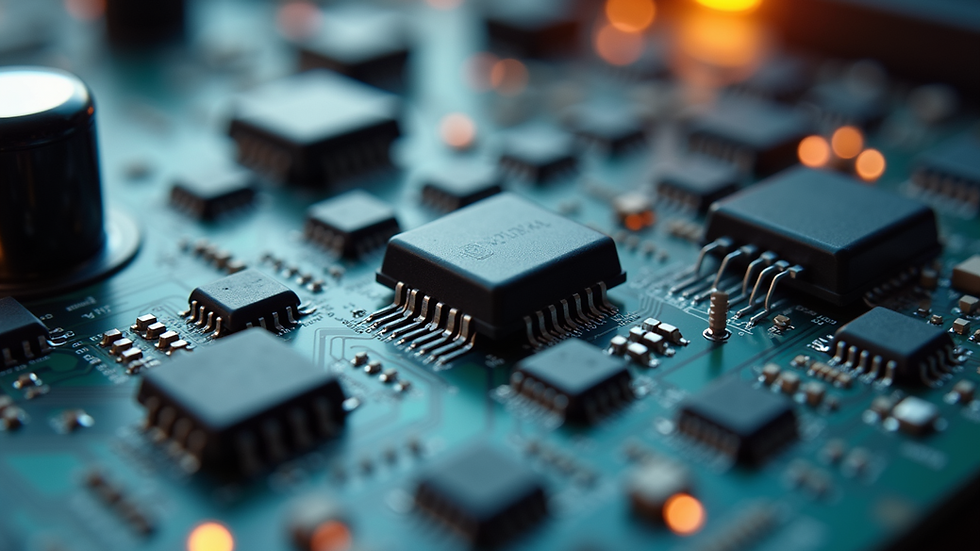Unlocking the Power of Transistors How These Tiny Components Power Our Everyday Lives
- Sanchit Kamat
- Aug 3
- 4 min read
Have you ever considered that nearly every electronic device we use every day is packed with billions of tiny components called transistors? If you haven’t, you’re not alone! Despite being the backbone of technology we rely on—like smartphones, computers, and hearing aids—most of us aren’t aware of their significance or function. This post aims to reveal the magic behind transistors and demonstrate why they are the building blocks of modern electronics.
What is a Transistor?
So, what exactly is a transistor? At its essence, a transistor serves as a small electronic switch that can turn current on or off and amplify signals. Think of a light switch. When you flip it to "on," the light shines; flip it to "off," and the light goes out. Similarly, a transistor controls how electricity flows through a circuit.
Transistors perform two main functions: switching and amplifying. For instance, when you speak into a microphone, the microphone uses transistors to amplify your voice, making it louder and clearer. Without transistors, our gadgets would lack the power and efficiency we take for granted today.
Types of Transistors
Transistors come in several types, but we'll highlight the three most common: NPN, PNP, and MOSFET.
NPN Transistors: These dependable workhorses allow current to flow easily from the collector to the emitter when the base is activated. For instance, they power the tiniest components in remote controls.
PNP Transistors: In contrast, current flows from the emitter to the collector when the base is activated. You can think of them as a mirrored version of NPN transistors, performing much the same role but in a different direction.
MOSFETs (Metal-Oxide-Semiconductor Field-Effect Transistors): These specialized transistors switch on and off very quickly and efficiently, making them ideal for fast-paced digital applications, such as in computer processors where speed is essential.
These types may differ in mechanics, but they ultimately serve the same purpose of managing electric current in a circuit efficiently.
How Does a Transistor Control Current?
Picture a water pipe with a valve that adjusts the flow of water. Similarly, a transistor can regulate how much electrical current moves through a circuit.
When a small voltage is applied to its base terminal, it enables a larger current to flow from the collector to the emitter (or the reverse, depending on the transistor type). Just like you can control the volume of water with a valve, transistors allow for precise management of electrical current, essential for tasks ranging from amplifying sound in your headphones to managing your computer’s data processing.
Why Are Transistors So Important?
Transistors are crucial to modern electronics for several reasons:
Efficiency: They regulate electrical signals with minimal energy loss. For example, smartphones can last longer between charges due to the efficient power management that transistors provide.
Scalability: Transistors can be made extremely small. Over 10 billion transistors can fit on a single computer chip, as seen in top-tier GPUs. This level of miniaturization has led to compact devices that are remarkably powerful.
Versatility: Transistors are used in a variety of applications, from amplifying signals in hearing aids to directing data flow in servers. This versatility makes them a cornerstone in the electronics industry.
A Brief History of Transistors
The transistor was invented in 1947 by John Bardeen, Walter Brattain, and William Shockley at Bell Labs. This invention marked a turning point in electronics, rendering the bulky vacuum tubes of the past obsolete.
Before transistors, machines were large, slow, and consumed a lot of power. The transistor's introduction facilitated the evolution of contemporary computers and triggered the tech revolution that has transformed society. Imagine a world without smartphones or laptops! It is astonishing to consider how much transistors have influenced our lives since their inception.
Real-Life Applications of Transistors
Now that you understand what a transistor is and why it’s vital, let’s explore some practical ways they enhance our daily lives:
Smartphones & Tablets: These devices depend on millions of tiny transistors to process information, maintain connectivity, and run applications smoothly.
Computers: A computer’s processor, packed with billions of transistors, handles complex calculations and powers software we use daily, like word processors and video games.
Hearing Aids: Transistors amplify sound, allowing individuals with hearing loss to engage better with their surroundings. For instance, modern hearing aids can feature over 1,500 transistors per device for improved performance.
Televisions: Transistors process signals that enhance your viewing experience by delivering sharper, clearer images and sounds.
Final Thoughts
Transistors may be small, but their impact on technology is undeniably huge. From the devices we depend on every day to the technological advancements that shape our future, transistors open up endless possibilities.
The next time you pick up your phone or power on your computer, take a moment to appreciate the remarkable little switches inside that make it all possible. Reflect on how far we've come since the invention of the transistor, and consider the innovations that lie ahead.
Now that you’re equipped with knowledge about transistors and their significance, share your understanding with others. Your newfound curiosity can guide you as you explore the exciting world of electronics!




Comments